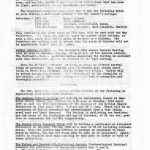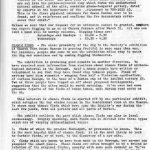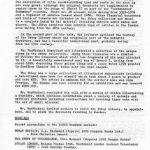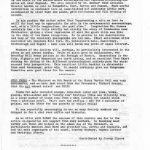Newsletter
Page 1
Our last lecture of the Winter Season will be given up 2nd April 1974 at the Central Library, The Burroughs, at 8.00 for 8.15p.m. Dr Gareth Davies, who is the Curator of the Verulamium Museum will speak on “Verulamium”. He was concerned in last summer’s excavations in the area, and has been asked to give any fresh information that has come to light, particularly of any pre-Roman settlement.
The Programme Committee would like you to put the following dates in your diaries — with brief details — for the summer’s outings:
Saturdays –
18th May – Lewes, Sussex
15th June – Bath, Somerset
13th July – Danebury, Petersfield, Hants
14th September – Compton Wyngates, Worm Leighton, Warwick
Full details of the first trip, on 18th May, will be sent with the May Newsletter. All those who can are urged to support these outings, as only a full coach will enable costs to be kept to a minimum; the Committee are working hard to ensure that the price of tickets will not be appreciably higher than last year.
Annual General Meeting
The Society’s 13th Annual General Meeting will be held on Tuesday 7th May at 8.15p.m. at the Central Library, The Burroughs, NW4. A formal notice summoning the meeting is enclosed with this Newsletter, as are the minutes of the 1973 meeting.
Once the official business is over, we shall be offered several items of interest: four members will illustrate with slides short talks on Skara Brae (Orkney), Italy, Turkey and Sicily. Coffee will be served during evening. Don’t be put off by the formality of the notice; we in HADAS aim to keep our AGMs both businesslike and thoroughly enjoyable!
Other Societies’ Events
The Hon. Secretary will supply further details of the following on application from interested members: —
The Wembley History Society are holding an Anniversary Dinner at Esso Motor Hotel, Empire Way, Wembley at 7.30p.m. on Tuesday 23rd April 1974 to mark the 50th Anniversary of the opening of the British Empire Exhibition on 23rd April 1924. Tickets are £4 a head. There will be an exhibition of B.E.E. souvenirs and entertainment from a West Indian steel band and Maori dancers. The Society is publishing to booklets, one of the story of the Exhibition and one of pictures, at £1 the two, post free or separately £0.25 and £0.80 respectively.
The Moated Sites Research Group will be holding a conference at Leicester University on Saturday 4th May 1974 at a cost of £1.40 including refreshments. Miss Ann Dornier has offered to arrange an excursion to local moats on Sunday 5th May for those able to stay on in Leicester. Application is required from those wanting to take part in either or both of these activities.
The Fulham and Hammersmith Historical Society (Archaeological Section) announce the publication of Occasional Papers Nos. 1 and 2.
1. The Fulham Pottery, a preliminary account … £0.50
2. A report on some of Archaeological Work in the Borough of Hammersmith … £0.25 (both post free).
Page 2
Church Terrace Dig
Under the existing arrangement with the London Borough of Barnet the Society’s activities on the Church Terrace site are to cease on 31st March 1974. So much interesting material is now being uncovered, however, that we have applied for an extension of that time limit, and if the Borough does not intend to begin re-development immediately, we have sought permission to continue excavation until such time as it becomes imminent.
This quotation from our Chairman’s letter to the Borough sums up the importance of the Church Terrace dig: —
“Today we can say with confidence that on the Church End site there is definite physical evidence for the existence of Saxon Hendon. This evidence consists of a complex ditch system, now clearly visible on the site. The dark fill of these Saxon ditches, which are cut into the yellow-coloured clay which forms the undisturbed natural subsoil of the site, contains grass-tempered pottery, dated by the experts at the Department of the Environment to 700-1050 AD. This is the first physical evidence for Saxon Hendon ever to be found, and it reinforces and confirms the few documentary references that exist.”
Unless we hear that our request for an extension cannot be granted, members may expect digging to go on at Church Terrace after 31st March. All who can lend a hand will be warmly welcomed. Digging times are: Saturdays and Sundays: 10.00-5.30 and Wednesdays: 10.30-4.30.
Chance Finds
The close proximity of the dig to the Society’s exhibition at Church Farm House Museum is proving fruitful in more ways than one. For instance, people who come to see the exhibition often stayed to watch the dig and sometimes end by coming digging themselves.
The exhibition is producing good results in another direction. We have received much information from visitors about chance finds of archaeological material in the Borough. Half-a-dozen people have written or telephoned to say that they have found clay tobacco pipes. Finds of pottery have been reported — ranging from half a Victorian candlestick, of curious design, to the base of a Samian cup of the 1st/2nd century AD. Two or three people have tipped us off about proposed developments, suggesting that the sites would be worth watching. We even had some gruesome reports of two finds of human bones, made during roadworks on the A1.
This interest in chance finds is sparked off by one particular exhibit, which occupies the bay window recess in the Westernmost room at the Museum. It shows many chance finds which have come the Society’s way during the last few years, from all periods and all parts of Barnet.
The exhibit outlines the part which chance finds can play in local archaeology. Roughly speaking, such finds can be divided into three types which are of varying archaeological value:
1. – finds of which the precise find-spot, or provenance is known. This is the most hopeful kind of chance find; it is the most likely to lead to further finds, or at best to the discovery of a new site.
2. – finds which are known to have been made in the Borough, but no one can pinpoint the exact place. These finds are often brought in by a friend or relation of the original finder, usually with some such comment as “we’ve had this for ages — my Dad found it long ago, somewhere by Copthall Fields (or Apex Corner or Hadley Highstone)”. The more vague the description of where the object was found, the less likely it is to lead to some discovery of archaeological importance.
3. – finds which have their own intrinsic interest (such as coins) but very little archaeological value, because nothing is known or remembered about where they came from. They cannot add to local knowledge, and they may even have been brought back from a holiday abroad.
All of which underlines the old archaeological maxim: it isn’t what you find that matters — is where and how you find it.
Contributed by BRIGID GRAFTON GREEN
Page 3
Report on March Lecture
Contributed by Elizabeth Holliday.
Forty six members of the Society were present at the March meeting when Mr N. H. MacMichael spoke about “The Documents and Manuscripts in the Westminster Abbey Library”.
Mr MacMichael divided his talk into three parts. The first, of particular interest to members, was about documents relating to Hendon in the Abbey archives. Among these are a collection of Anglo-Saxon charters, rewritten in the twelfth century, including the Charter of St. Dunstan, which records the grant of Hendon to Westminster Abbey. The collection of title deeds recording land and rents in the area is not very great, although the original documents are supplemented by copies taken in the reign of Edward II as part of the “Westminster Domesday” records. There are 28 account rolls dating from 1319-1376 and a register of estates leased about 1486. Other financial documents and lists of tenants are included in the Abbey collection and there is a complete index to material including entries under names and places. The Abbey archives also contain maps of estates in the Hendon area dating from the eighteenth century.
In the second part of his talk, the lecturer outlined the history of the Abbey library which was originally part of the monastic dormitory, and has a beautiful hammer-beam roof, probably dating from the fifteenth century.
Mr MacMichael described and illustrated a selection of the unique items in the Abbey collection. Among these treasures are a charter of William the Conqueror which still has fragments of his seal attached to it; a beautiful embroidered seal bag of Edward I, dating from about 1290, depicting three golden lions, and a lease dated 1399 granted to Geoffrey Chaucer for a house near the main chapel.
The Abbey has a large collection of illuminated manuscripts including a two-volumed mass book (or missal) which took about two years to produce and cost £35. The artist is unknown but the scribe’s name was John Preston. The missal was lent recently for an exhibition and was insured for £300,000.
Mr MacMichael concluded his talk with a series of slides illustrating a bestiary, which contains information about a variety of animals and mythical creatures including instructions for catching tiger cubs with the aid of small mirrors!
Mr MacMichael invited members to visit the Abbey Library, by appointment, and to study the documents relating to Hendon.
Book Box
Recent accessions to the HADAS book box include:
ROMAN BRITAIN, I. A. Richmond (Reprint 1970 Penguin Books Limited) – from Christine Arnott
THE STORY OF TUTANKHAMUN, Otto Neubert (Reprint 1972 Dragon Books)
STUART LONDON, Malpas Pearce (Pub MacDonald London Weekend Television 1969) – from Dorothy Newbury
A COUNTRY CAMERA 1844-1914, Gordon Winter (Penguin Books 1973) – from Paul Carter
Many thanks to the three members who added these books to the box. Any other editions will be very welcome, if in good condition and dealing with archaeology and related subjects.
The full book list is now available upon request from the Hon. Librarian, George Ingram. If you have already asked for it there is no need to apply again. George will be sending you your copy in a few days time.
Page 4
Book Review
Contributed by Philippa Bernard
Discovering Regional Archaeology — South East England — by Edward Sammes
It is with a considerable sense of pride that we draw readers’ attention to this new publication by prominent member of the Society. One of the useful little “Discovering ” books published by Shire Publications, this is the ninth in the series which investigates and explains archaeological sites all over England. The area covered by Mr Sammes book includes Greater London as well as Hampshire, Kent, Surrey and Sussex. Much useful information is condensed into an easy-to-read yet scholarly little work, accompanied by clear maps and plans, grid references and full details of access.
In his preface the author notes that “approaching a site on foot is still the best way to appreciate the site in its environmental surroundings, and, with a little imagination, the past also”. Imagination Mr Sammes certainly has — he tells briefly but vividly the story of Fishbourne near Chichester, giving a clear impression of what the great villa was like in the time of its Roman occupation. He is precise in his descriptions and many of the excellent photographs are his own. Other well-known and sites are mentioned Danebury Hill Fort, St. Catherine’s Hill, Canterbury, Richborough and Bignor — some less well-known may prove of equal interest.
Members of the Society will, perhaps, be particularly interested in sites in and around London. Pride of place in goes to Sulloniacae, the Brockley Hill Roman Pottery in the Borough of Barnet. Excavations in the City, Highgate and Hampstead are worth noting, and an excellent Time Chart showing the dating of the different archaeological periods puts the whole account into perspective. This excellent little booklet is obtainable from most bookshops, price £0.40. It should certainly give our Programme Committee some good ideas for the summer.
Stop Press
Contributed by Jeremy Clynes
The Minimart on 9 March at the Henry Burden Hall was very successfully, and we have just heard from the Treasurer, Richard Deacon, that the net amount raised was £115!
Items for sale included stamps, home-made cakes and jams, books, plants, bric-a-brac and a “nearly new” boutique (this was literally true as a large number of items came from a shop turning out unsold stock from a previous year.). There were two raffles — one for a selection of prizes, and the other for two packets of toilet rolls!
It was especially encouraging to see so many members who dropped in for a chat over coffee and biscuits.
As so often with HADAS the success of this venture was due to the active co-operation and support from many members. In thanking most warmly all those who helped on the actual date of the Minimart, we particularly mention Joan Bird who provided tea, coffee and biscuits, and the main organisers of the event, Dorothy Newbury, Daphne Lorimer and Christine Arnott.
This newsletter has been edited by Christine Arnott.




